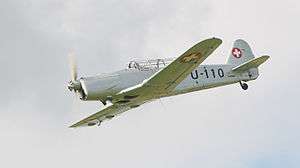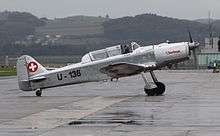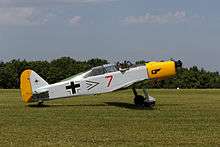Pilatus P-2
The Pilatus P-2 is a trainer aircraft designed by Swiss manufacturer Pilatus in 1942 and first flown on April 27, 1945. It was used by the Swiss Air Force from 1946 until 1981. The Pilatus P-2 emerged from an unbuilt project of the Pilatus P-1, which can be seen as a single-seat version of the P-2.
| P-2 | |
|---|---|
 | |
| Role | Trainer |
| National origin | Switzerland |
| Manufacturer | Pilatus Aircraft |
| First flight | 27 April 1945 |
| Retired | 1981 |
| Primary user | Swiss Air Force |
| Number built | 55[1] |
Design and development
The P-2 is a low-wing monoplane of mixed construction (metal, wood and fabric) with a fully retractable tailwheel undercarriage and dual control tandem seating. To save cost, several parts came from older Swiss AF machines, for example landing gear parts from their Messerschmitt Bf 109s. There were two series of production machines, one (P-2-05) unarmed and the second (P-2-06) equipped as weapons trainers, with a machine gun above the engine and wing racks for light bombs and rockets.
After the end of their Swiss Air Force service, the survivors (numbering about 48) were sold into civilian service. In 2008 at least 23 appeared on the national registers of Switzerland, Germany, France, the United Kingdom and the United States. They proved to be a popular civil flyer's aeroplane and have often appeared in Luftwaffe garb in films and airshows as an unidentified "enemy" aircraft.
Variants


- P-2-01
- First prototype (HB-GAB/A-101/U-101), Argus-powered.
- P-2-02
- Non-flying static testframe.
- P-2-03
- Hispano-Suiza HS-12Mb upright V water-cooled engined prototype. Large ventral radiator.
- P-2-04
- Armed version of P-2-03.
- P-2-05
- Production version of unarmed machine, Argus motor. 26 delivered to Swiss AF.
- P-2-06
- Production version of armed machine, Argus motor. 26 delivered to Swiss AF.
Specifications (P-2)
Data from Jane's All the World's Aircraft 1951–52[2]
General characteristics
- Crew: 2
- Length: 9.07 m (29 ft 9 in)
- Wingspan: 11 m (36 ft 1 in)
- Height: 2.70 m (8 ft 10 in)
- Wing area: 17.0 m2 (183 sq ft)
- Aspect ratio: 7.1:1
- Fuel capacity: 225 l (59 US gal; 49 imp gal) in three tanks
- Powerplant: 1 × Argus As 410A-2 V-12 inverted air-cooled piston engine, 280 kW (370 hp) rated at 2,000 m (6,600 ft) ; 347 kW (465 hp) for take-off
- Propellers: 2-bladed Argus constant-speed propeller
Performance
- Maximum speed: 340 km/h (210 mph, 180 kn) at 2,500 m (8,200 ft)
- Cruise speed: 332 km/h (206 mph, 179 kn) maximum at 3,300 m (10,800 ft)
- Economical cruising speed: 306 km/h (190 mph; 165 kn) at 4,500 m (14,800 ft)
- Landing speed: 105 km/h (65 mph; 57 kn)
- Never exceed speed: 720 km/h (450 mph, 390 kn)
- Range: 865 km (537 mi, 467 nmi) in still air at Economical cruising speed with full fuel
- Rate of climb: 6.5 m/s (1,280 ft/min)
- Take-off run: 231 m (758 ft) from grass
- Landing run: 157 m (515 ft) on grass
References
| Wikimedia Commons has media related to Pilatus P-2. |
- "Pilatus P-2". samoloty. Archived from the original on 8 December 2011. Retrieved 29 March 2019.
- Bridgman 1951, p. 190c
- Bridgman, Leonard, ed. (1947). Jane's all the World's Aircraft 1947. London: Sampson Low, Marston & Co.CS1 maint: ref=harv (link)
- Bridgman, Leonard, ed. (1951). Jane's All the World's Aircraft 1951–52. London: Sampson Low, Marston & Co., Ltd.CS1 maint: ref=harv (link)
Further reading
- The Illustrated Encyclopedia of Aircraft (Part Work 1982-1985). Orbis Publishing.
- Green, William; Pollinger, Gerald (1954). The World's Fighting Planes. London: MacDonald.
- Green, William; Pollinger, Gerald (1965). The Aircraft of the World (3rd ed.). London: MacDonald. p. 113.